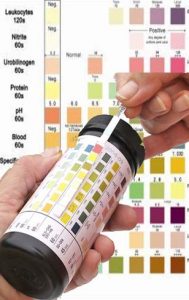Why Is There Urobilinogen In My Dog Or Cat’s Urine?
Ron Hines DVM PhD
 See What Normal Blood & Urine Values Are
See What Normal Blood & Urine Values Are

Urobilinogen is a breakdown product of the hemoglobin in your dog and cat’s red blood cells (RBCs).
Red blood cells, also called erythrocytes, live, at the most, four months. When they wear out, they are reprocessed in your pet’s spleen. The iron portion of the hemoglobin within the RBC is recycled to make new RBCs, while the heme portion is converted into bilirubin. That bilirubin is normally excreted into the intestine with your pet’s bile. Some of the bilirubin that reaches the intestine that way is then converted into urobilinogen by bacteria living in the dog or cat’s intestine. Some of that Urobilinogen (~10%) is later reabsorbed back into your pet’s blood stream.
Most bilirubin that was reabsorbed is excreted again by its liver in an endless cycle. But some eventually finds it way into your pet’s urine. Most veterinary hospitals have urine dipsticks with a small square of chemicals that change color in the presence of urobilinogen.
A small amount of urobilinogen in your dog or cat’s urine is normal.
Reasons Why Your Dog or Your Cat’s Urine Urobilinogen Level Might Be High:
Anytime the level of bilirubin being sent to your pet’s intestine is elevated, increased amounts of urobilinogen will appear in its urine as well. You can go to my explanation of the causes of increased blood bilirubin levels here.
Health issues that cause large amounts of your pet’s red blood cells to be destroyed while in circulation liberate hemoglobin and result in high blood bilirubin that eventually causes elevated urobilinogen levels in its urine as well.
One of these causes of red blood cell destruction is hemolytic anemia. It is more common in dogs than cats. A form of hemolytic anemia (primarily in dogs) is caused by autoimmune disease – situations where the pet’s immune system cells form antibodies against its own red blood cells (autoimmune hemolytic anemia). Hemolytic anemia can also be caused by toxins liberated by invading bacteria, blood parasites that live in red blood cells and toxins that are ingested. On occasion, an unexpected reaction to a medication causes hemolytic anemia.
Occasionally, liver disease prevents the pet’s liver from efficiently removing formed urobilinogen and re-excreting it into the bile. In those cases, blood levels of bilirubin and eventually urine levels of urobilinogen often rise as well.
As I mentioned, blood parasites of dogs and cats (e.g. haemobartonella/aka Mycoplasma haemofelis in cats) are also capable of causing the destruction of large numbers of RBCs releasing hemoglobin, some of which eventually ends up as urine urobilinogen.
Fenbendazole, given to kill intestinal parasites has been known to cause red blood cell destruction, as has acetaminophen (Tylenol) when given to cats. In some cases, that is because of red blood cell destruction, in others it is because toxic effects on the liver prevent the organ from re-excreting blood bilirubin effectively.
Reasons Your Pet’s Urine Urobilinogen Level Might Be Low:
Since urobilinogen is formed by your pet’s intestinal bacteria from bilirubin excreted in the dog or cat’s bile, anything that interferes with normal bile flow can prevent bacterial urobilinogen formation which lowers the amount in its blood and urine. So, a low urobilinogen reading might suggest a bile duct obstruction (obstructive jaundice or gall stones) if other tests agree. However, the urine urobilinogen test is not accurate enough to rule out a bile duct obstruction when urobilinogen is present in normal amounts in your pet’s urine.
Tetracycline and other antibiotics can destroy many of the intestinal bacteria that produce urobilinogen. When that occurs, your dog or cat’s urine urobilinogen level could be low or absent.
Certain urinary acidifiers (e.g. ammonium chloride, ascorbic acid/vitamin C) can cause falsely low urine bilirubin readings.
Both the pH of your dog or cat’s urine and the concentration (SpGr) of its urine can affect its urobilinogen reading. (read here)
DxMe



 Causes Of Most Abnormal Blood & Urine Tests
Causes Of Most Abnormal Blood & Urine Tests